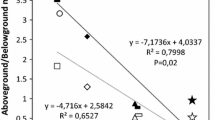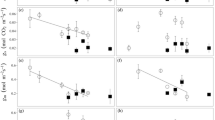Abstract
It has been argued that plants adapted to low light should have lower carbon losses via dark respiration (Rd) than those not so adapted, and similarly, all species would be expected to down-regulate Rd in deep shade, because the associated advantages of high metabolic potential cannot be realized in such habitats. In order to test these hypotheses, and to explore the determinants of intraspecific variation in respiration rates, we measured Rd, leaf mass per unit area (LMA), and nitrogen content of mature foliage in juveniles of 11 cold-temperate tree species (angiosperms and conifers), growing in diverse light environments in forest understories in northern Minnesota. Among the seven angiosperm species, respiration on mass, area, and nitrogen bases showed significant negative overall relationships with shade tolerance level. Mass-based respiration rates (Rd mass) of angiosperms as a group showed a significant positive overall relationship with an index of light availability (percentage canopy openness, %CO). Rd mass of most conifers also showed evidence of acclimation of Rd mass to light availability. LMA of all species also increased with increasing %CO, but this response was generally much stronger in angiosperms than in conifers. As a result, the response of area-based respiration (Rd area) to %CO was dominated by ΔRd mass for conifers, and by ΔLMA for most angiosperms, i.e., functional types differed in the components of acclimation of Rd area to light availability. Among the seven angiosperm species, the relationships of leaf N on a mass basis (N mass) with %CO were modulated by shade tolerance: negative slopes in shade-tolerant species may be related to the steep increases in LMA of these taxa along gradients of increasing light intensity, and associated dilution of N-rich, metabolically active tissue by increasing investment in leaf structural components. Although N mass was therefore an unreliable predictor of variation in Rd mass along light gradients, respiration per unit leaf N (Rd/N) was significantly positively correlated with %CO for most species. This probably reflects variation in the proportion of leaf N allocated to protein and/or the influence of leaf carbohydrate status on Rd. Species shade tolerance differences were not significantly correlated with the magnitude of either ΔRd mass or ΔRd area, indicating that variation in acclimation potential of Rd is much less important than inherent differences in this trait. Acclimation of Rd mass to light availability appears to be a generalized feature of juvenile trees, and the important ecological trade-off is likely between high metabolic capacity in high light and low respiratory losses in low light.
Similar content being viewed by others
Author information
Authors and Affiliations
Additional information
Received: 15 April 1999 / Accepted: 24 October 1999
Rights and permissions
About this article
Cite this article
Lusk, C., Reich, P. Relationships of leaf dark respiration with light environment and tissue nitrogen content in juveniles of 11 cold-temperate tree species. Oecologia 123, 318–329 (2000). https://doi.org/10.1007/s004420051018
Issue Date:
DOI: https://doi.org/10.1007/s004420051018




